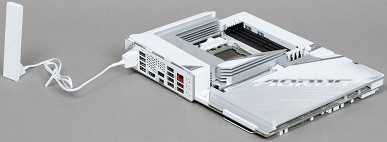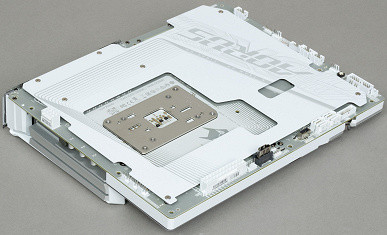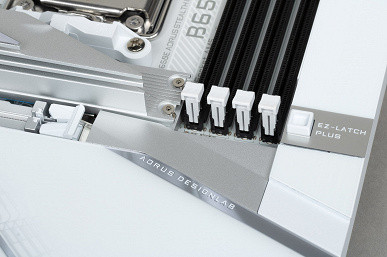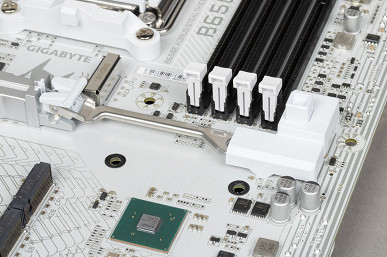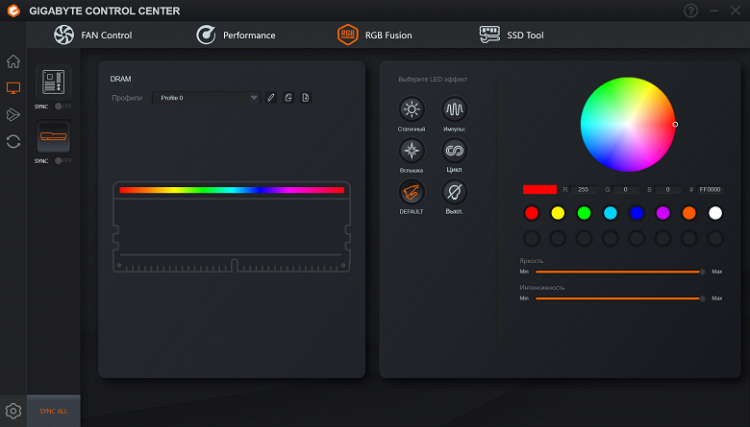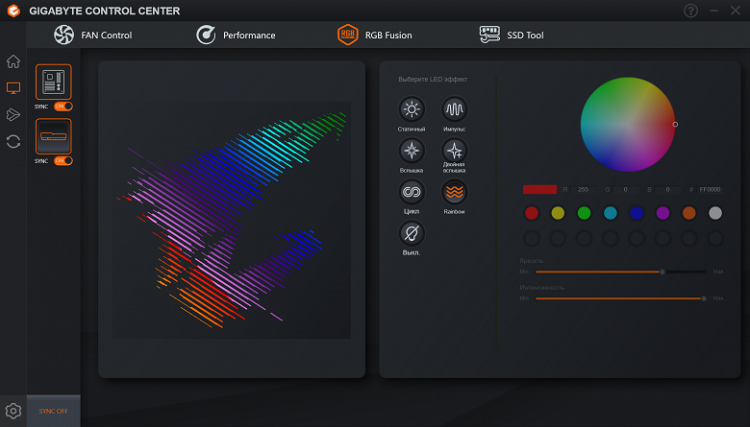We continue to study motherboards, their power supply system, peripheral connectivity options, and available software solutions with which they enter the market. Particular attention is paid to the analysis of processors.
Today we received an unusual product — a motherboard with connectors moved to the back side. Gigabyte includes such solutions in the Stealth series. We have already tested similar models and were convinced that such a design simplifies PC assembly and improves the appearance, eliminating the need to see the wires inside the case. This time we are studying a Gigabyte board based on the mid-priced AMD B650 chipset, but in the B650E version.
Recall that the key difference between the B650 and B650E chipsets, as well as the X670 and X670E, is the support of PCIe 4.0 for the PCIe x16 slot in versions without «E» and PCIe 5.0 in versions with «E».
Table of the main differences between the B650 and X670.
| Peculiarities | B650/ B650E | X670/ X670E |
|---|---|---|
| Compatibility with AMD processors | Ryzen 7xxx/8xxx/9xxx | Ryzen 7xxx/8xxx/9xxx |
| PCIe Version (CPU) | 4.0 & 5.0/ 5.0 | 4.0 & 5.0/ 5.0 |
| Number of PCIe lanes (processor) | 28 | 28 |
| Number of PCIe lanes from the processor to the chipset | x4 PCIe 4.0 | x4 PCIe 4.0 |
| PCIe version (chipset) | 3.0 & 4.0 | 3.0 & 4.0 |
| Number of PCIe lanes (chipset) | 12 (8 x 4.0 & 4 x 3.0) | 20 (12 x 4.0 & 8 x 3.0) |
| RAM generation | DDR5 | DDR5 |
| Number of RAM channels | 2 | 2 |
| Maximum number of RAM slots | 4 | 4 |
| Maximum RAM | 192 GB | 192 GB |
| Number of SATA 6.0 Gb/s ports up to | 4 | 8 |
| USB 3.2 Gen 2x2 ports (20Gbps) up to | 1 | 2 |
| USB 3.2 Gen 2x1 (10Gbps) / Gen 1x1 (5Gbps) ports up to | 6 | 8 |
| USB 2.0 ports up to | 6 | 12 |
| Possibility of overclocking by bus frequency | Yes | Yes |
We know that in addition to the main brand, Gigabyte has a sub-brand Aorus, under which the most top and advanced products are released. Today's motherboard, despite using a mid-range chipset, belongs to this line — Gigabyte B650E Aorus Stealth Ice based on AMD B650E. The question arises: is this really a flagship model? Or rather a sub-flagship? Or maybe even lower?
Let's try to figure it out.
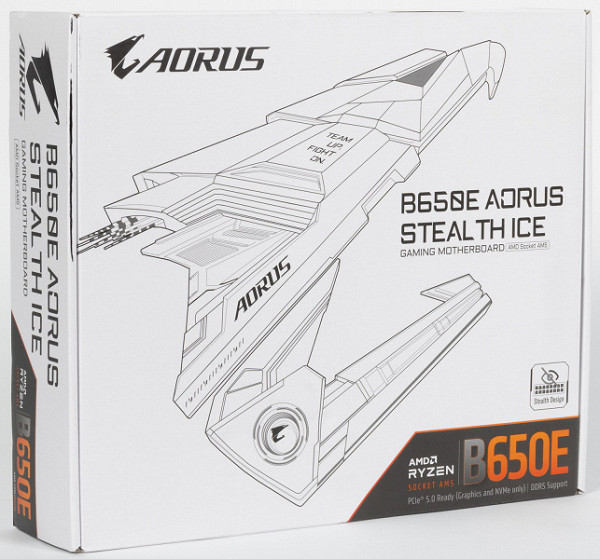
The Gigabyte B650E Aorus Stealth Ice comes in the Aorus series' signature eagle-shaped cardboard packaging, done in white tones to match the color of the board itself. The insides of the box are neatly organized, with the kit placed in separate sections under the board.
While this model is not the flagship of the Aorus line, the package contents are quite modest: in addition to standard items such as a user manual and SATA cables, the kit includes an antenna for the built-in Wi-Fi/BT module and a proprietary G-connector for connecting the front panel. There are no bonus stickers.

The software is not supplied in the kit, but this is not critical, since by the time of purchase it will be outdated anyway. After purchasing, it is better to immediately download updates from the manufacturer's website.
The plug for the rear panel connectors is already pre-installed on the board itself, which simplifies installation.
Form factor
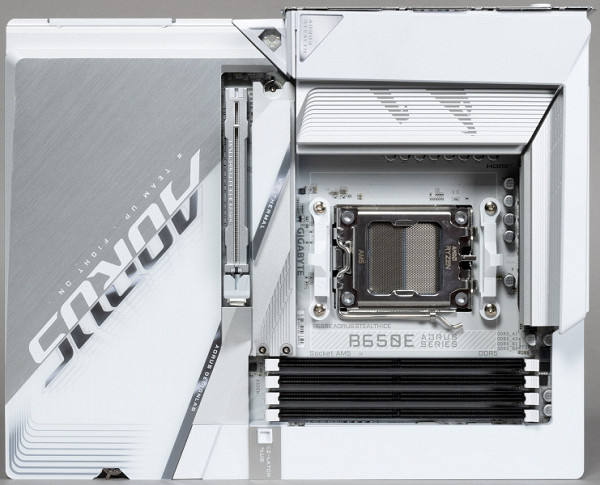
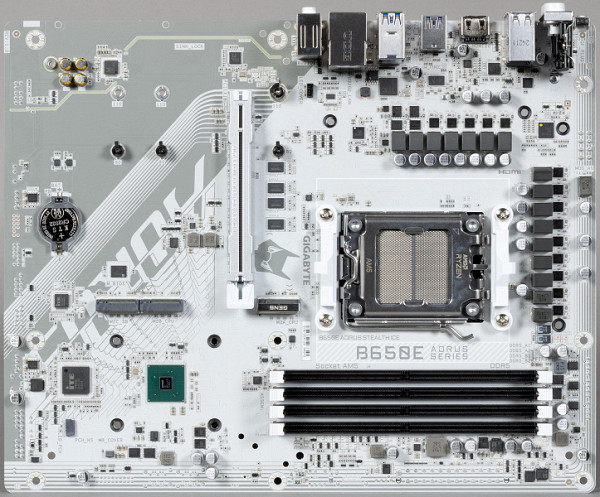
The ATX form factor assumes dimensions up to 305×244 mm, and E-ATX — up to 305×330 mm. The Gigabyte B650E Aorus Stealth Ice motherboard has dimensions of 305×244 mm, which corresponds to the ATX form factor. It has 9 mounting holes for installation in the case. However, it is worth considering that some of them may be covered by radiators or other design elements.
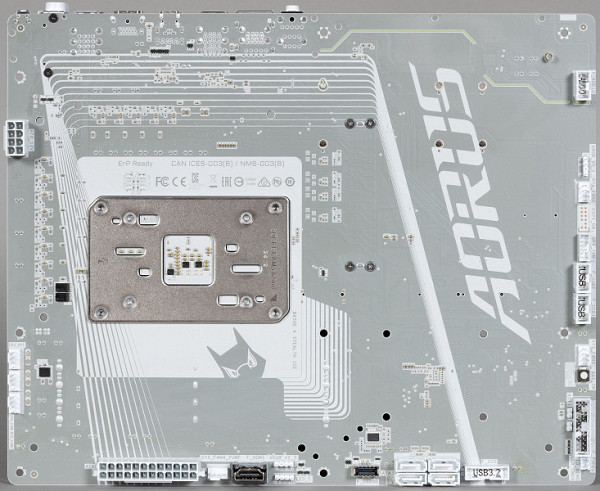
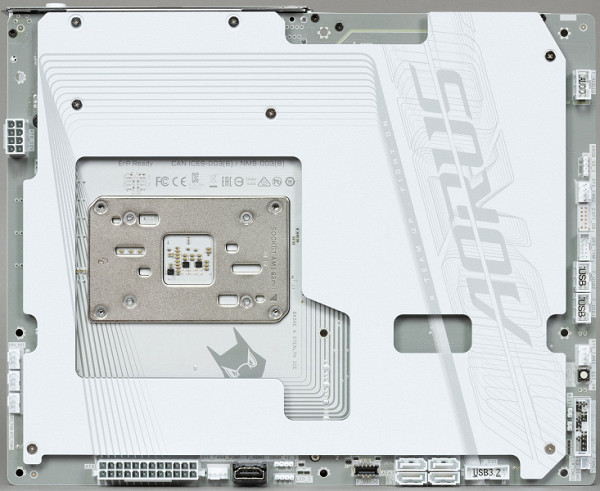
The main feature of the motherboard is the placement of all connectors on the back side. The PCIe slot and M.2 slots are on the front side (which is logical -).
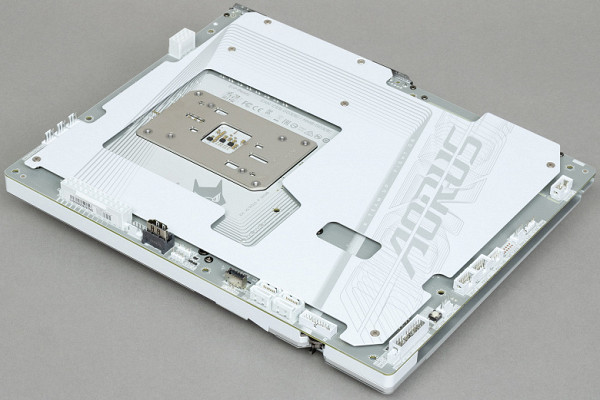
On the back side of the board, there is practically nothing except for the connectors and fasteners of the processor socket. The textolite is processed qualitatively: all sharp ends of the solder are cut and carefully polished. Also on the back side there is an aluminum plate with a nanocarbon coating, which gives the board additional rigidity, but does not perform the function of heat dissipation, since there is no thermal interface. As for the covered mounting holes, the design provides for magnetic pads on the panel. After removing them, the mounting points for installing the board in the case become available.
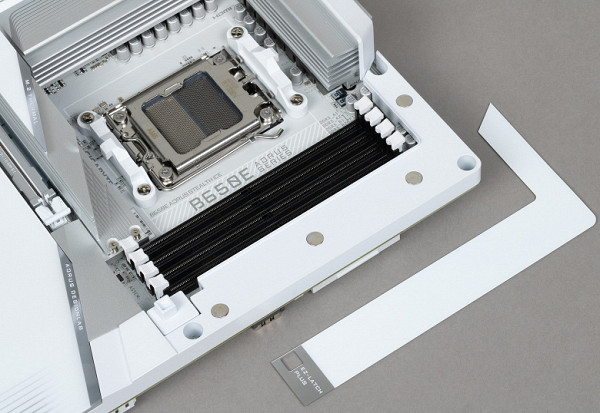
Technical specifications
Traditional table with a list of functional features.
| Supported Processors | AMD Ryzen 7xxx/8xxx/9xxx under AM5 |
|---|---|
| Processor socket | AM5 |
| Chipset | AMD B650E |
| Memory | 4 × DDR5, up to 192 GB, up to DDR5-8000 (XMP/Expo), two channels |
| Audio subsystem | 1×Realtek ALC897 (7.1) |
| Network controllers | 1 × Realtek RTL8125D Ethernet 2.5 Gbps 1 × MediaTek Dual Band Wireless MT7925 (Wi-Fi 7 802.11a/b/g/n/ac/ax (2.4/5/6 GHz) + Bluetooth 5.4) |
| Expansion slots | 1×PCI Express 5.0 x16 |
| Storage connectors | 4 × SATA 6 Gb/s (B650E) 1 × M.2 (M2A_CPU, CPU, PCIe 5.0 x4 for 2280/2 5 80/22110/2 5 110 devices) 1 × M.2 (M2B_CPU, CPU, PCIe 4.0 x4 for 2280/22110 devices) 1 × M.2 (M2С_SB, B650E, PCIe 4.0 x4 for 2280/22110 devices) |
| USB ports | 4×USB 2.0: 4 Type-A ports (Black)(GL850G) 4×USB 2.0: 2 x 4-port internal headers (B650E) 2×USB 3.2 Gen1: 1 x 2-port internal header (B650E) 5×USB 3.2 Gen1: 5 x Type-A ports (Blue) (RTS5411+B650E) 1×USB 3.2 Gen2x2: 1 x Type-C internal connector (B650E) 1×USB 3.2 Gen2: 1 x Type-C port (CPU) 2×USB 3.2 Gen2: 2 x Type-A ports (Red) (CPU) |
| Rear panel connectors | 1 × USB 3.2 Gen2 (Type-C)/DP-out 2 × USB 3.2 Gen2 (Type-A) 5 × USB 3.2 Gen1 (Type-A) 4 × USB 2.0 (Type-A) 1 × RJ-45 3 mini-jack audio connectors 1 × HDMI-out 2 antenna connectors BIOS flashing button — Q-Flash Plus |
| Other internal elements | 24-pin ATX power connector 1 8-pin EPS12V power connector 1 M.2 slot (E-key), occupied by a wireless network adapter 1 connector for connecting a USB 3.2 Gen2x2 Type-C port 1 connector for connecting 2 USB 3.2 Gen1 ports 2 connectors for connecting 4 USB 2.0 ports 6 connectors for connecting 4-pin fans and ZSO pumps 1 connector for connecting a non-addressable RGB strip 2 connectors for connecting an addressable ARGB strip 1 audio connector for the front panel of the case 1 connector for resetting CMOS 1 TPM connector for security systems 1 connector for connecting Thunderbolt cards 2 connectors for thermal sensors 1 connector for connecting front panel control 1 universal Reset connector (configurable in BIOS) 1 universal Reset button (configurable in BIOS) |
| Form factor | ATX (305×244 mm) |
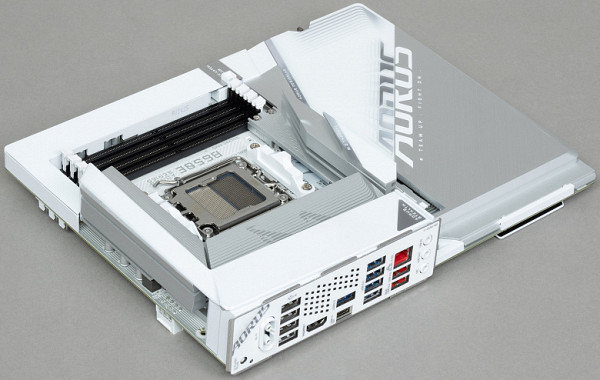
Main functionality: chipset, processor, memory

Scheme of operation of the chipset+processor bundle.

All Ryzen 7000, 8000, and 9000 series processors support:
- 3 USB 3.2 Gen2 Type-C ports,
- 1 USB 3.2 Gen2 Type-A port,
- 1 USB 2.0 port.
Only Ryzen 7000 and 9000 support:
- 28 I/O lanes (including PCI-E 5.0, downgraded to 4.0 when using the A620 chipset):
- 4 lanes (downgraded to PCI-E 3.0 in the case of the A620) for communication with the chipset,
- 16 lanes — PCI-E 4.0 slot for video cards,
- 8 remaining PCI-E 4.0 lanes: 4 for the M.2 slot, 4 at the choice of the motherboard manufacturer.
Only Ryzen 8700/8600 support:
- 20 I/O lanes (PCIe 4.0):
- 4 lanes (with A620 reduced to PCI-E 3.0) for communication with the chipset,
- 8 lanes — PCI-E 4.0 slot for video cards,
- 8 remaining PCI-E 4.0 lanes: 4 for the M.2 slot, 4 at the manufacturer's choice.
Only Ryzen 8500/8300 support:
- 14 I/O lanes (PCIe 4.0):
- 4 lanes (with A620 reduced to PCI-E 3.0) for communication with the chipset,
- 4 lanes — PCI-E 4.0 slot for video cards,
- 6 remaining PCI-E 4.0 lanes: 4 for the M.2 slot, 2 at the manufacturer's choice.
B650/B650E chipsets support:
- Up to 6 USB 3.2 Gen2 ports,
- 1 USB 3.2 Gen2x2 port,
- 6 USB 2.0 ports,
- 12 I/O lanes: 8 PCIe 4.0 + 4 PCIe 3.0,
- PCIe 3.0 lanes can include up to 4 SATA ports.
As a result, the B650/B650E combination with Ryzen 7000/9000 processors provides:
- 16 PCI-E 5.0 lanes for video cards (from the processor),
- 1 USB 3.2 Gen2x2 port (from the chipset),
- 10 USB 3.2 Gen2 ports (4 from the processor, 6 from the chipset),
- 7 USB 2.0 ports (1 from the processor, 6 from the chipset),
- 4 SATA 6 Gbps ports (from the chipset, via PCIe 3.0 lanes),
- 8 PCI-E 5.0 lanes (from the processor), of which 4 are for the M.2 slot, and the remaining 4 can be used by the motherboard manufacturer,
- 8 PCI-E 4.0 lanes (from the chipset) for flexible port and slot configuration,
- 4 PCI-E 3.0 lanes (from the chipset) for additional configuration.
Total: up to 18 USB ports and up to 20 free PCI-E lines, including up to 4 SATA ports.
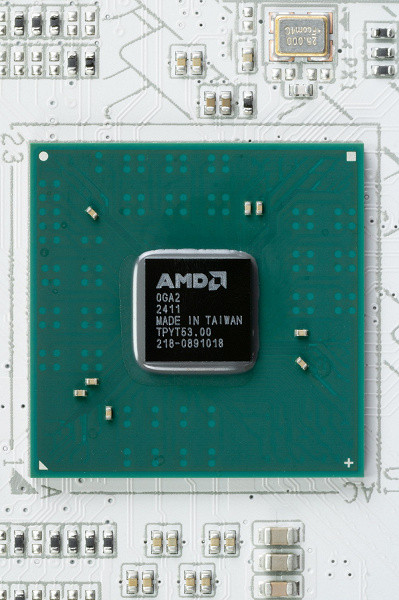
Let me remind you that the AMD B650 and B650E chipsets are identical in functionality (including the set of ports and lanes). However, the main difference is that the PCIe x16 slot for video cards connected to the processor supports PCIe 5.0 in the case of the B650E, and PCIe 4.0 in the case of the B650.
Ryzen 7xxx, 8xxx, and 9xxx series processors support DDR5 memory, including modules with Intel XMP (Extreme Memory Profile), which can be configured via Direct Over Clock Profile (DOCP) to operate according to XMP parameters, as well as modules with the proprietary AMD Expo profile.
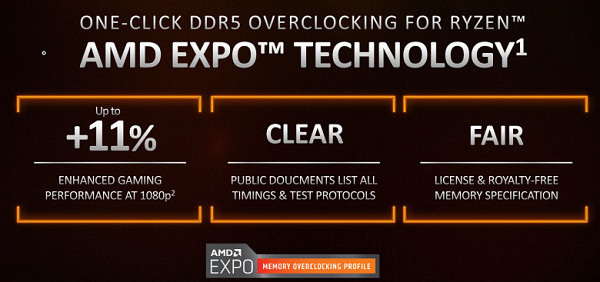
Gigabyte B650E Aorus Stealth Ice supports AMD 7000/8000/9000 generation processors made for the AM5 socket.

The board has four DIMM slots for installing memory modules. For operation in Dual Channel mode, when installing two modules, it is recommended to place them in slots A2 and B2. The board supports unbuffered DDR5 memory with a maximum capacity of up to 192 GB, as well as XMP and Expo memory overclocking profiles.

The slots do not have a metal frame (to protect against interference), but the wires to the RAM are carefully shielded.
Peripheral functionality: PCIe, SATA, various additional devices
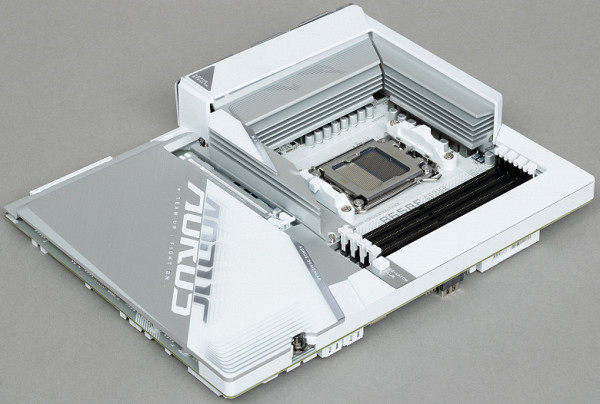
Above we have studied the potential capabilities of the B650E+Ryzen tandem, and now let's see what of this and how it is implemented in this motherboard.
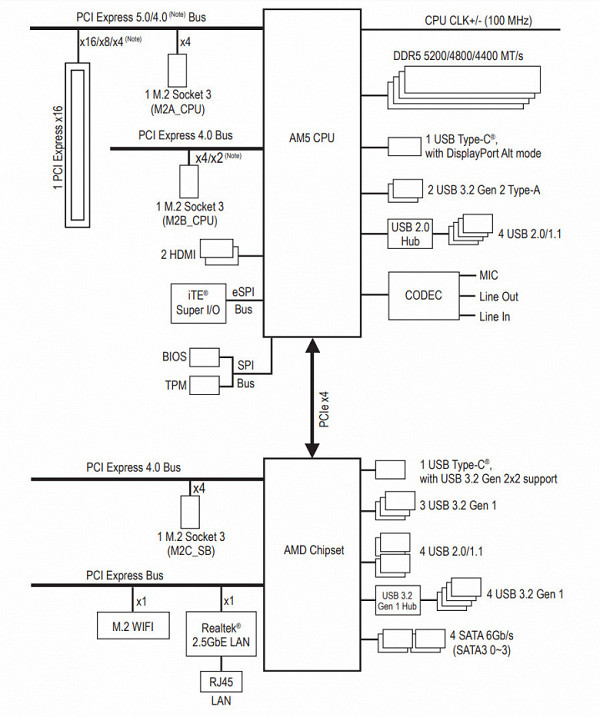
The B650E chipset provides 12 PCIe lanes, and here's how they are distributed among the elements:
- M.2 port (M2C_SB) — 4 PCIe 4.0 lanes;
- SATA ports 0,1,2,3 — 4 PCIe 3.0 lanes;
- Realtek RTL8125D (Ethernet 2.5 Gb/s) — 1 PCIe 4.0 lane;
- Mediatek MT7925 (Wi-Fi 7/BT) — 1 PCIe 4.0 lane.
A total of 10 PCIe lanes are occupied (6 version 4.0 lanes and 4 version 3.0 lanes), including 4 SATA ports.
Now let's look at how the PCIe lanes are distributed in Ryzen 7xxx/8xxx/9xxx processors, which have 24 PCIe lanes (plus 4 lanes for communication with the chipset):
- M.2 port (M2A_CPU) — 4 PCIe 5.0 lanes;
- M.2 port (M2B_CPU) — 4 PCIe 4.0 lanes;
- PCIe x16_1 slot — 16 PCIe 5.0 lanes.
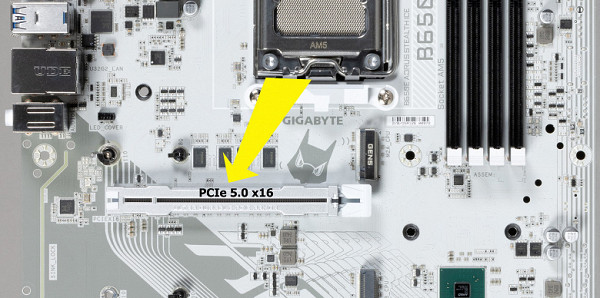
Ryzen processors have a built-in High Definition Audio (HDA) controller, which interacts with the audio codec via PCI bus emulation. Also, the USB 2.0 Genesys Logic GL850G controller uses a USB 2.0 line from the processor, and the Realtek RTS5411 connects to one USB 3.2 Gen1 line from the B650E chipset (details will be in the section on USB ports).
The board has one PCIe x16 version 5.0 slot that receives data from the processor. This slot has metal reinforcement, which increases its reliability. This is especially important when frequently changing video cards, since the reinforced structure copes better with the load and bending, especially when installing heavy top-end video cards. In addition, such reinforcement protects the slot from electromagnetic interference.

To simplify the removal of video cards from the slot, there is a long side «lever» with an EZ-Latch-Plus button. When you press this button, the slot lock is released, which allows you to easily remove the video card.
The motherboard supports installation of cooling systems of any size.
There are no resource divisions and switching of slots and ports, so multiplexers are not used. There is also no external clock generator.
Now let's move on to the drives.
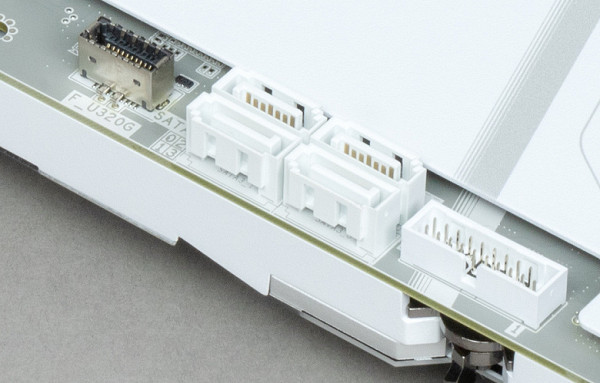
The board has 4 Serial ATA 6 Gbps connectors and 3 slots for M.2 drives. All SATA ports are connected via the B650E chipset and support RAID creation, while they are located on the back of the board in a vertical position.

The motherboard has 3 M.2 form factor sockets.
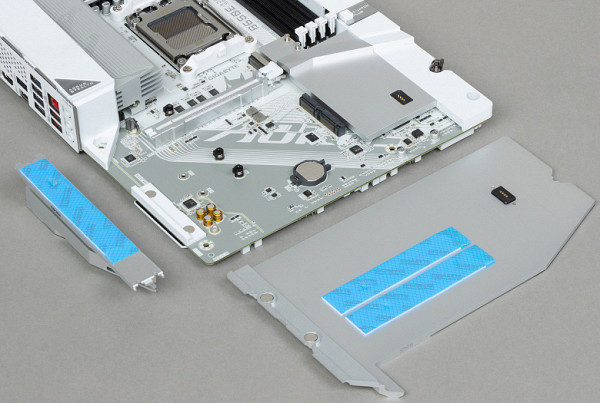
All three slots support module sizes 22110 and 2280, and M2A_CPU is also compatible with 25110 and 2580 modules. All slots only work with modules on the PCIe interface: two slots (M2A_CPU and M2B_CPU) are connected to the processor, and one slot (M2C_SB) receives data from the B650E chipset.
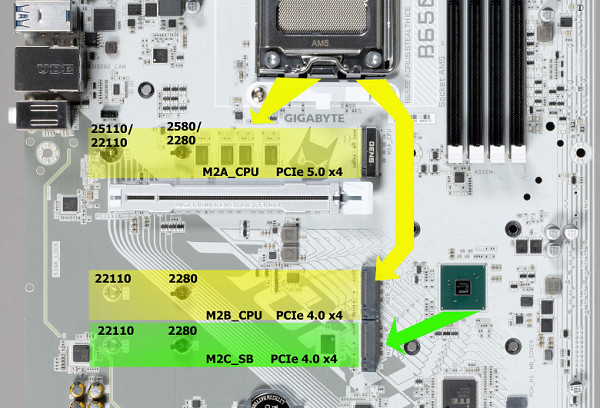
All M.2 slots have heatsinks. The top M2A_CPU has a separate heatsink, while the other M.2s share a common heatsink.

Peripheral functionality: USB ports, network interfaces, input/output
Next up are the USB ports. Let's start with the back panel, where most of them are located.
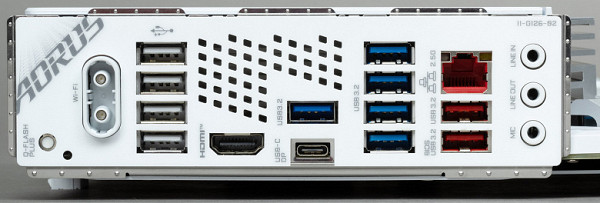
So, the B650E chipset can provide a maximum of: 6 USB 3.2 Gen2/1 ports, 1 USB 3.2 Gen2x2 port, and 6 USB 2.0 ports. Ryzen 7000/8000/9000 processors support up to 4 USB 3.2 Gen2 ports and 1 USB 2.0 port.
It is also worth considering the 12 PCIe lanes from the chipset, which are spent on supporting drives, network and other controllers (as already mentioned, 10 lanes were used for specific purposes).
In total, the motherboard provides 19 USB ports, including:
- 1 USB 3.2 Gen2x2 port, implemented via the B650E and available as an internal Type-C port.
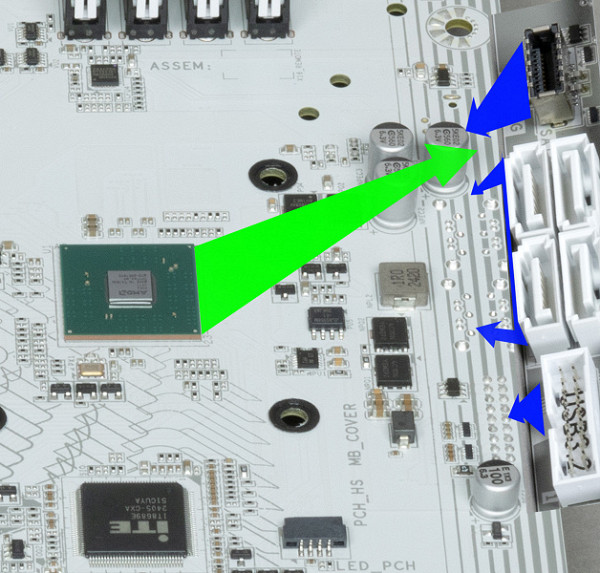
for connection to the corresponding connector on the front panel of the case;
- 3 USB 3.2 Gen2 ports: all implemented via the CPU and represented on the rear panel by two Type-A ports (red) and 1 Type-C port;
- 7 USB 3.2 Gen1 ports: 3 implemented via the B650E, with 2 represented by an internal connector on the motherboard for 2 ports,
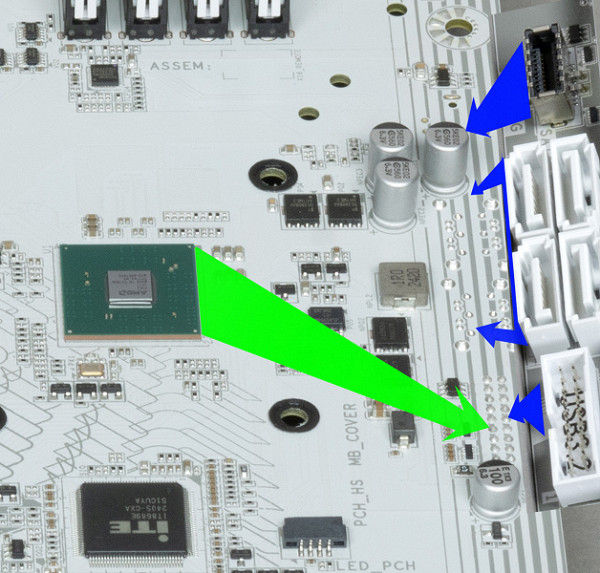
and 1 is represented on the rear panel by the Type-A port (blue); another 4 are implemented via the Realtek RTS5411 controller
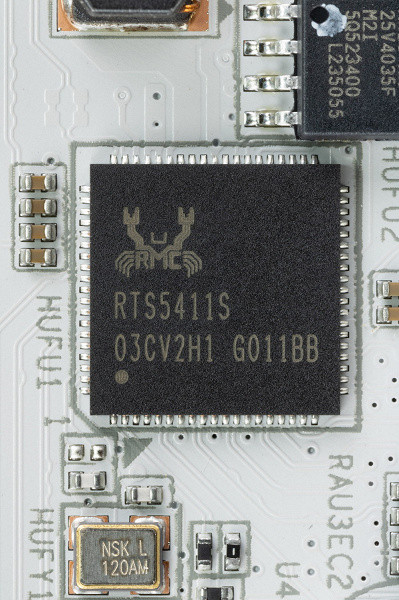
(1 USB 3.2 Gen1 line from B650E is spent on it) and are represented on the rear panel by 4 Type-A ports (blue);
- 8 USB 2.0/1.1 ports: 4 are implemented via B650E and are represented by two internal connectors (each with 2 ports);
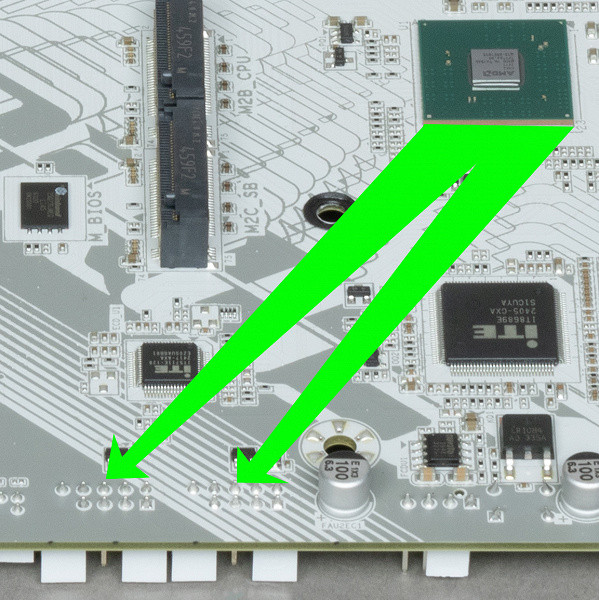
4 more are implemented via the Genesys Logic GL850G controller

(1 USB 2.0 line from the CPU is spent on it) and is represented by 4 Type-A ports on the rear panel (black).
So, the B650E chipset supports the following ports: one USB 3.2 Gen2x2, three USB 3.2 Gen1, and five USB 2.0 (with the wireless controller requiring one USB 2.0 lane).
In addition, 10 PCIe lanes are allocated to support other peripherals. In total, the B650E provides 14 high-speed ports.
All Type-A and Type-C ports have PI3EQX1004 signal amplifiers from Diodes Inc. (former Pericom).
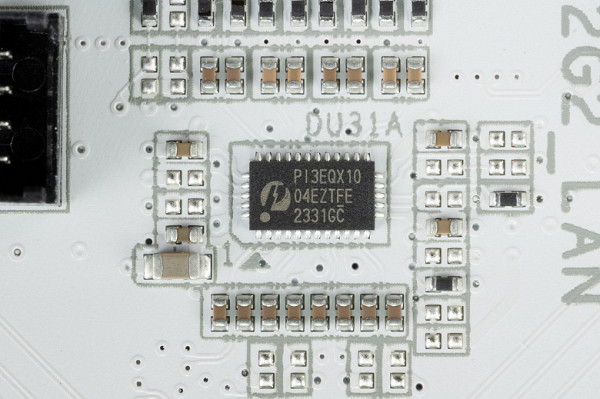
And for fast charging needs, the Type-C port on the rear panel and a similar internal port for output to the front panel have redrivers from Realtek.
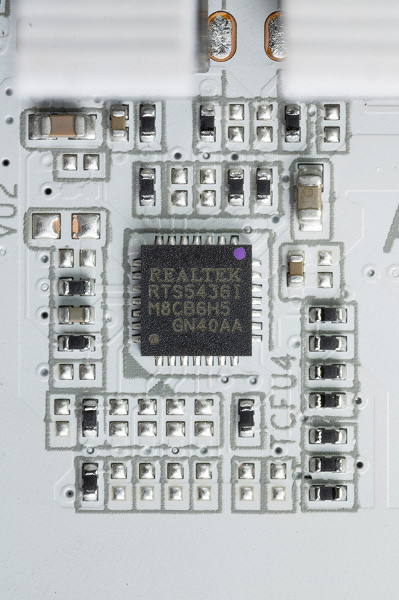
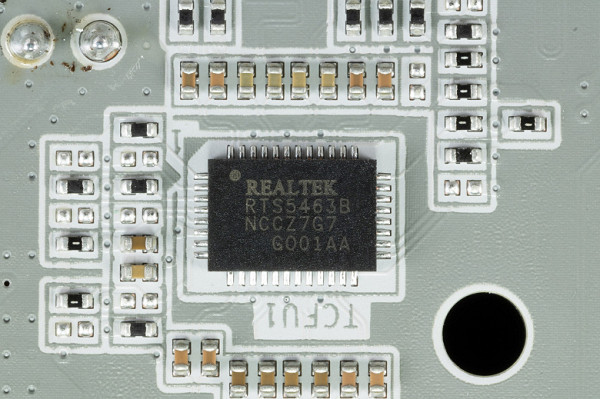
Now about network matters.

The motherboard is well equipped with communication facilities. There is a high-speed Ethernet controller: Realtek RTL8125D, capable of delivering up to 2.5 Gbit/s.

The motherboard has a wireless adapter on the MediaTek MT7925 controller, which supports Wi-Fi 7 (802.11a/b/g/n/ac/ax/be) and Bluetooth 5.4. The adapter is located in the M.2 slot (E-key), and the connectors for connecting external antennas are located on the rear panel.
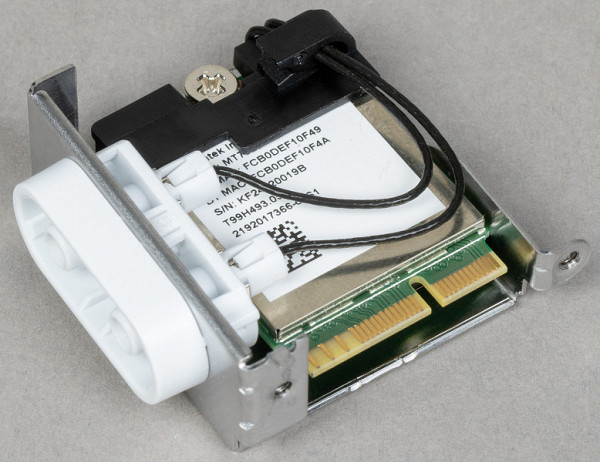
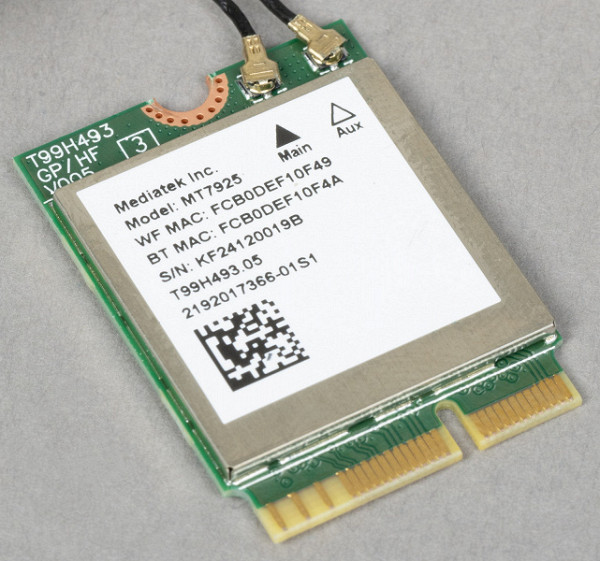
This adapter implements a new antenna connection scheme — using plastic locks (without screwing the antenna wire tips).
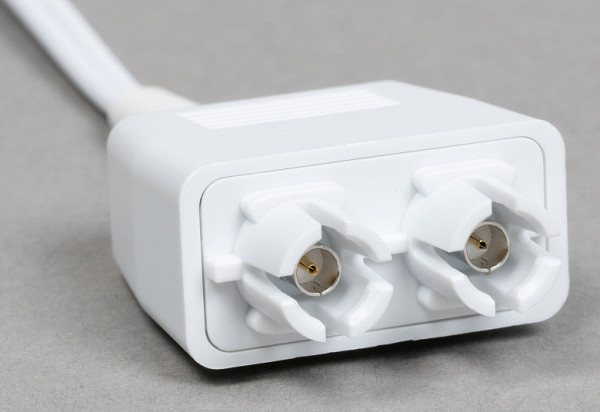
The plug, traditionally placed on the rear panel, is already placed in this case and is shielded from the inside to reduce electromagnetic interference.

Audio subsystem
The motherboard is equipped with an outdated Realtek ALC897 audio codec, which supports sound schemes up to 7.1 with a resolution of up to 24 bits / 192 kHz. To implement 7.1-channel sound, you need to use three jacks on the back of the motherboard, and also connect the internal audio output to the front panel of the case, using the Line-out on the case as a fourth jack.
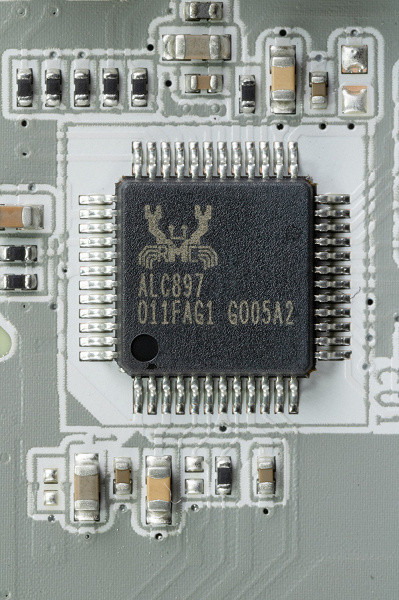
There are no DACs or operational amplifiers.
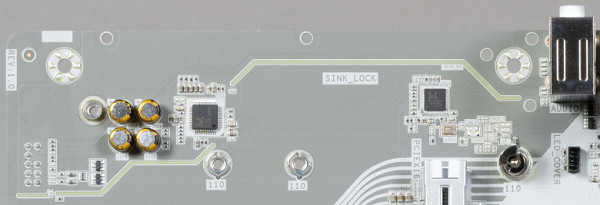
The board uses «audiophile» capacitors in the audio circuits. The audio path is located in the corner of the board, which prevents it from intersecting with other components. Three standard connectors are provided on the rear panel for receiving and outputting signals, but there is no S/PDIF connector.
Power, cooling
To power the board, it has 2 connectors: in addition to the 24-pin ATX, there is another ATX12V (8 contacts).
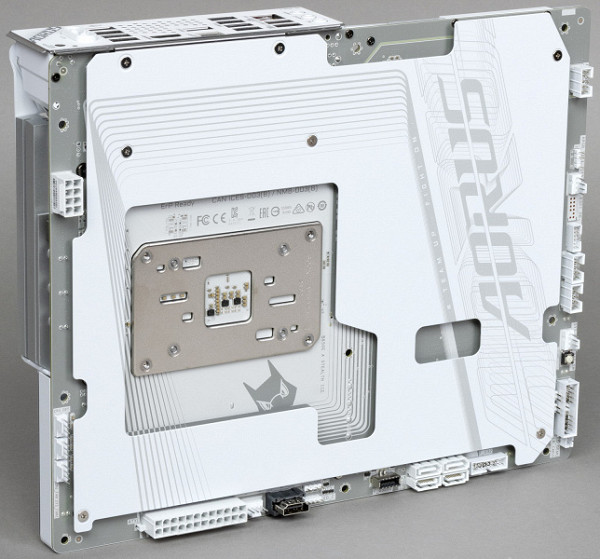
For a motherboard with a mid-budget chipset, the power supply system looks quite impressive.

Externally, the power supply circuit looks like 12+2+2: 12 phases — processor core, 2 phases — SoC (Ryzen I/O chiplet), 2 phases — VDD_MISC (integrated graphics output).

The VCore and SoC phases are controlled by the RT3678 digital controller from Richtek, which supports a maximum of 10 phases. In practice, the core power phases are controlled in parallel, resulting in 6x2 (VCore) + 2 (SoC) = 8 real power phases controlled by this PWM controller.
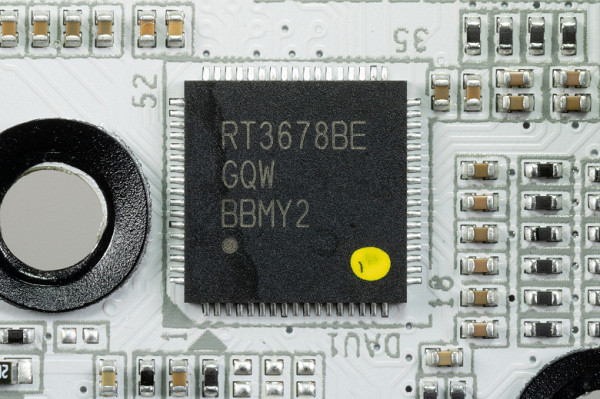
Power phases VDD_MISC — controlled by PWM controller RT3672 from Richtek.
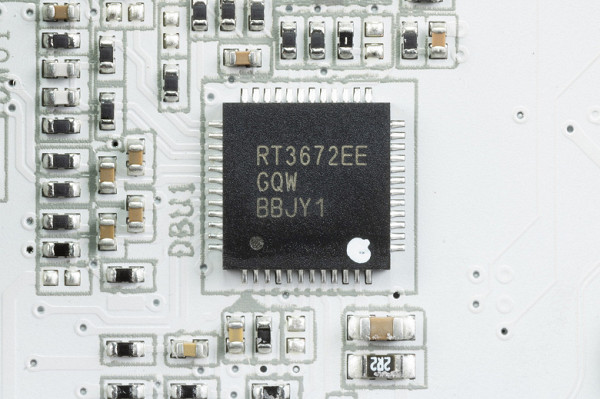
Each phase of the VCore and SoC has a transistor assembly NCP302155 from On Semi (up to 55A).
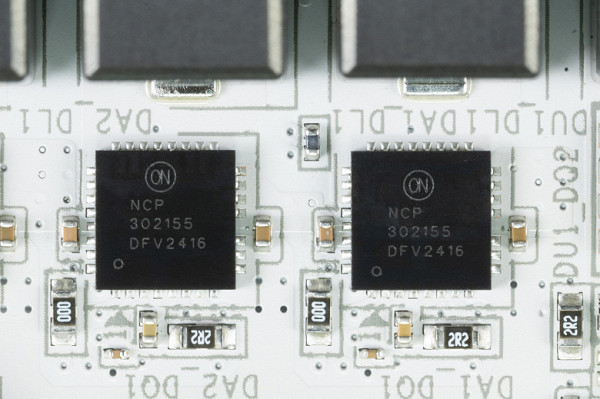
The VDD_MISC power supply is supplied by a set of NTMFS4C10N/4C06N FETs from On Semi (up to 69A).
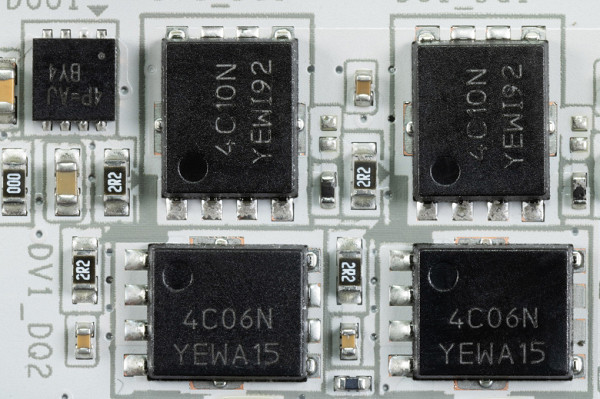
Now about cooling.
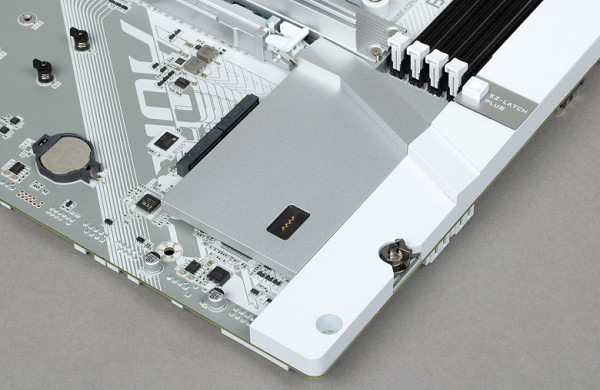
All elements that can get very hot are equipped with their own radiators. The B650E chipset has a wide radiator that effectively copes with cooling without the need for a fan. The rest of the cooling components are standard and familiar.

Two groups of power converters have their own separate radiators, connected by a heat pipe.
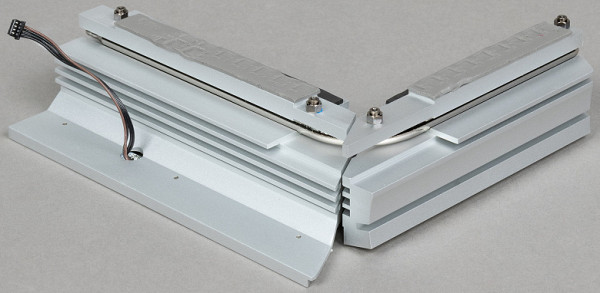
Two groups of power converters have their own separate radiators, connected by a heat pipe.
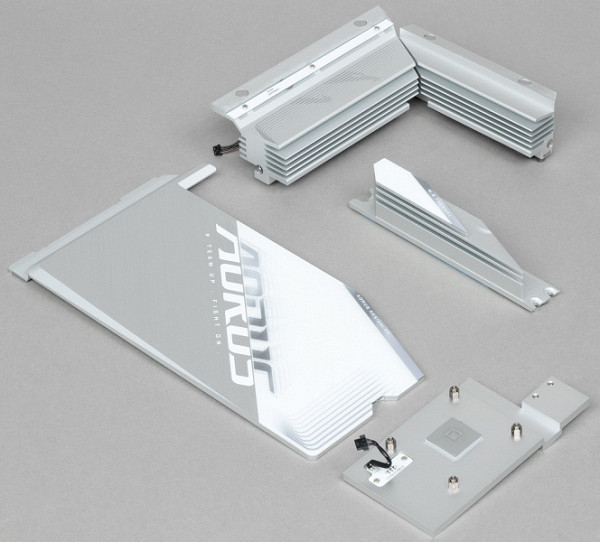
The motherboard has a backplate on the reverse side, which has the functions of protecting the motherboard, as well as strengthening the rigidity.

Backlight
On this board, lighting effects are implemented on the inside of the rear port block casing and on the right near edge under the plastic insert. There are also three connectors for connecting external lighting, and all elements are controlled via the Gigabyte Control Center program.
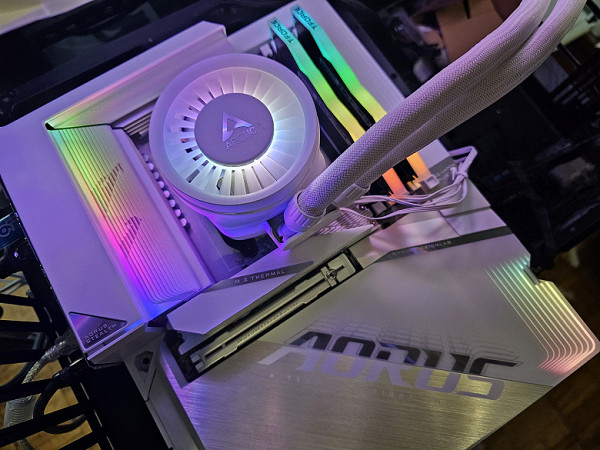
If you don’t like the backlight, you can always turn it off via software.

Control is carried out using the RGB Fusion utility already built into the Gigabyte Control Center.
Software for Windows
All software is available for download on the manufacturer's website Gigabyte.com. Management is carried out through the universal Gigabyte Control Center application, which combines all previously separately offered company utilities.
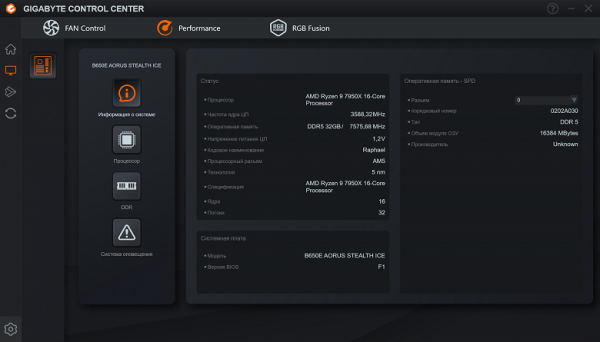

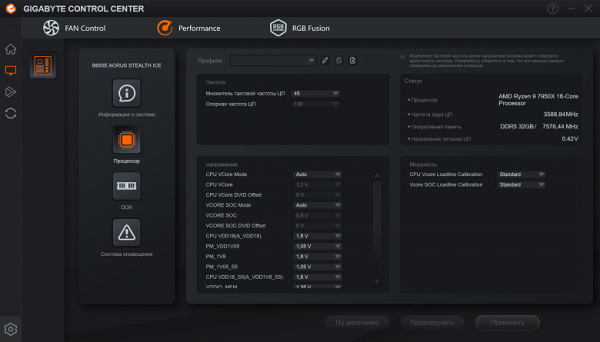

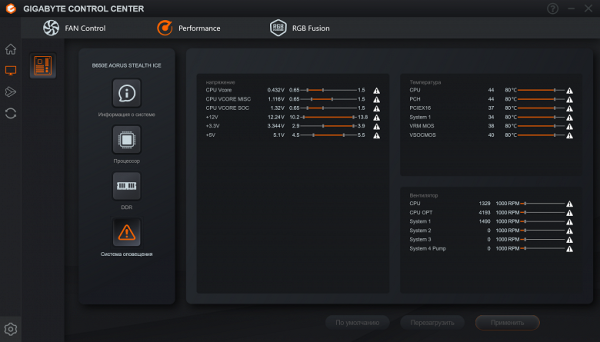

You can adjust the board's operation not only by frequencies or voltages, but also by regulating the operation of the fans.
BIOS settings
All modern motherboards now have UEFI (Unified Extensible Firmware Interface), which are essentially operating systems in miniature. To enter the settings when booting the PC, you traditionally need to press the Del or F2 key.
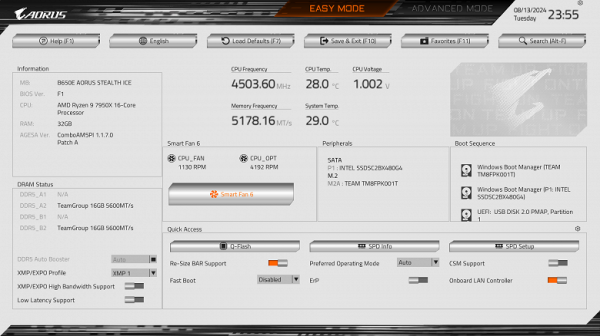
We get into the general “simple” menu, where you can configure a limited number of parameters, so we click on Advanced mode at the top and get into the “advanced” menu.
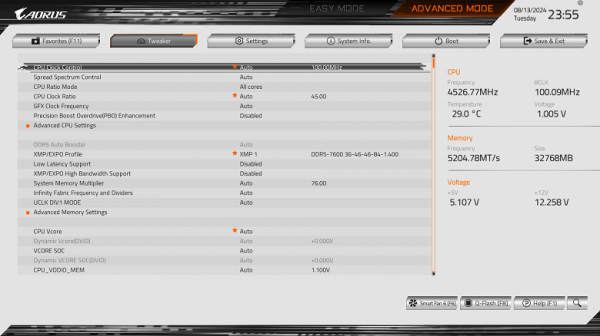
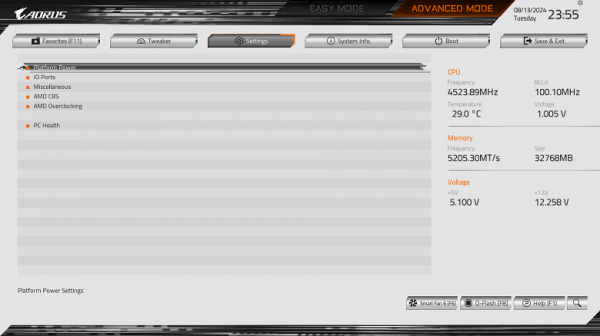
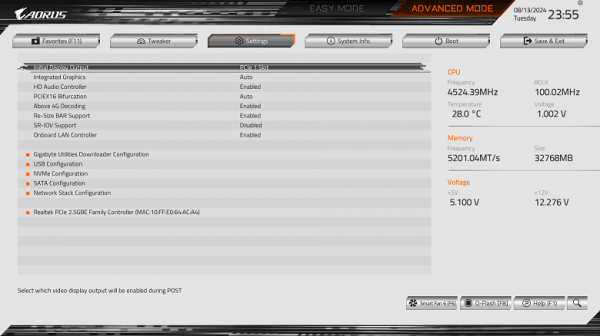

Peripheral management, you can control each USB port, change the operating modes of PCIe and M.2 slots.
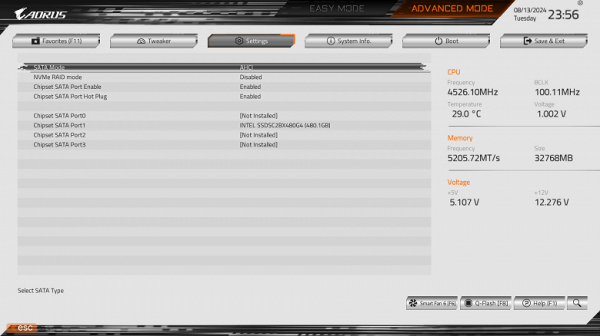
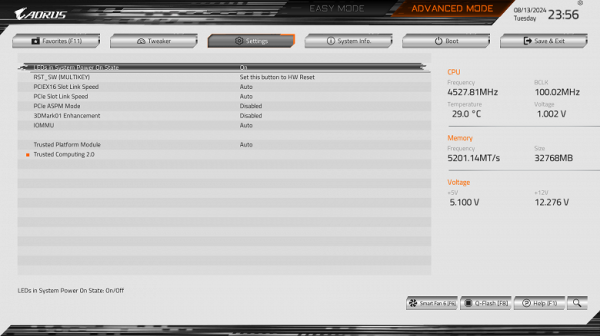
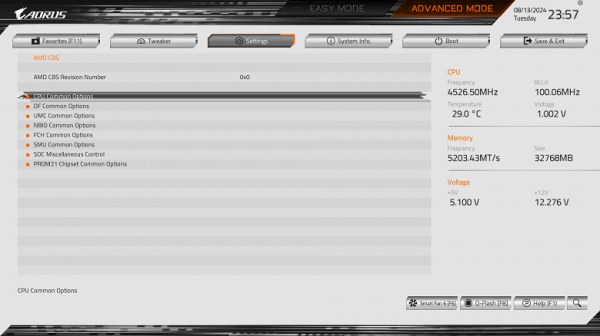
Monitoring and boot menu options are well known to everyone. There is also a Smart Fan 6 utility for configuring fan sockets.
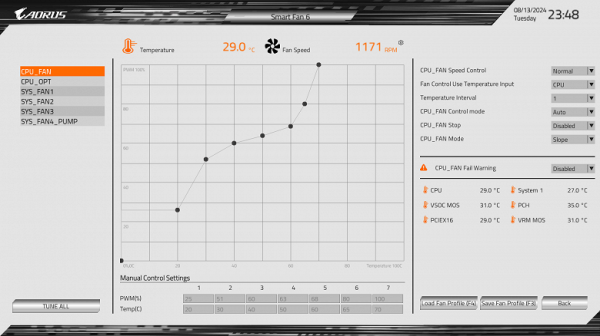
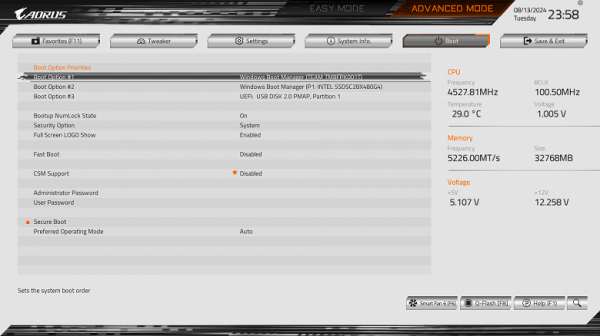
For overclocking, there are essentially already standard options within the framework of what Ryzen processors and RAM support.


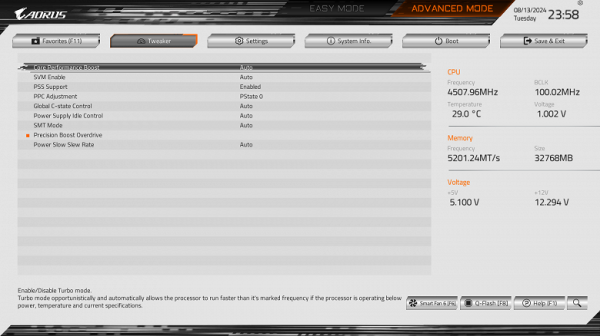
For overclocking, there are essentially already standard options within the framework of what Ryzen processors and RAM support.
Performance (and overclocking)
Full configuration of the test system :
- Gigabyte B650E Aorus Stealth Ice motherboard;
- AMD Ryzen 9 7950X 4.5 — 5.5 GHz processor;
- TeamGroup T-Force Delta RGB RAM 32 GB (2×16) DDR5 (CL36-46-46-84) (XMP 7600 MHz);
- TeamGroup MP44L NVMe PCIe 4.0 1TB SSD drive;
- Palit GeForce RTX 3050 StormX graphics card ;
- Power supply Super Flower Leadex Platinum 2000W (2000 W);
- LSS Arctic Liquid Freezer III 420 ARGB ;
- TV LG 55Nano956 (55″ 8K HDR);
- USB — keyboard and mouse.
Software:
- Operating system Windows 11 Pro, 64-bit
- AIDA 64 Extreme
- 3DMark Time Spy CPU benchmark
- 3DMark Fire Strike Physics benchmark
- 3DMark Night Raid CPU benchmark
- HWInfo64
- OCCT v.13.1.4
- Adobe Premiere CS 2019
We launch everything in default mode. Then we load it with tests from OCCT.
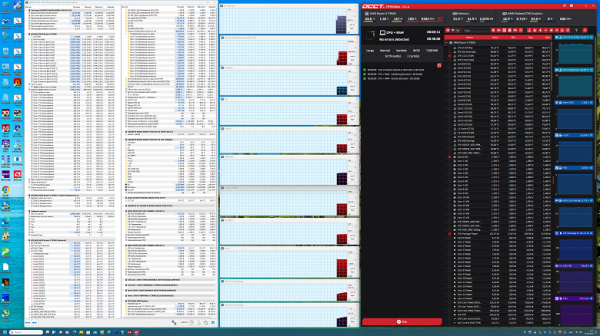
Modern overclocking technologies from Intel (Turbo Boost) and AMD (Precision Boost) regulate the frequency increase limits based on information about the motherboard power supply system and chipset capabilities, thanks to digital controllers and data available in UEFI.
It is important to note that this board effectively implements IF (Infinity Fabric) frequency control with the Auto mode set, and the memory frequency multiplier is automatically adjusted.
Auto-overclocking of this board in standard mode demonstrated excellent results, reaching 5.3 GHz on all cores, which is a good indicator for a motherboard on an average budget chipset. All tests were carried out without complaints about the operation of related components, without overheating or other problems.
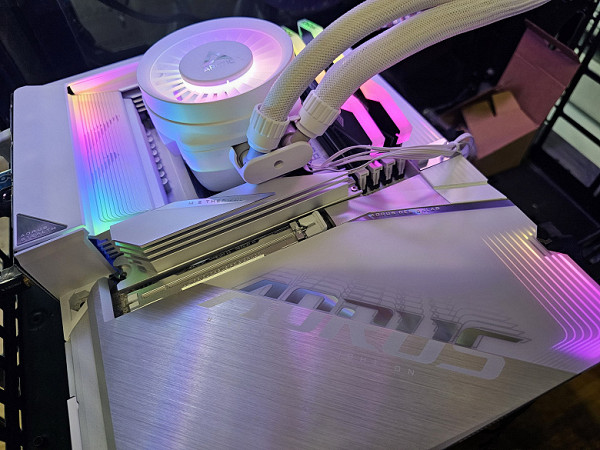
Conclusions on the motherboard
The Gigabyte B650E Aorus Stealth Ice motherboard is a sub-flagship product based on the AMD B650E chipset, part of the Aorus series for AM5 processors, with an estimated price of about 30-35 thousand rubles. It is compatible with AMD Ryzen 7000/8000/9000 processors and is designed for gamers and advanced users.
One of the unique features of this board is the location of almost all connectors (except for memory slots, PCIe and M.2) on the back side of the PCB. This solution helps to avoid an untidy look of cables in computers with transparent walls and spectacular lighting. Cable management is organized in the rear part of the case, which is logical and simplifies cable management. However, to install such a board, you will need a case that supports this configuration.
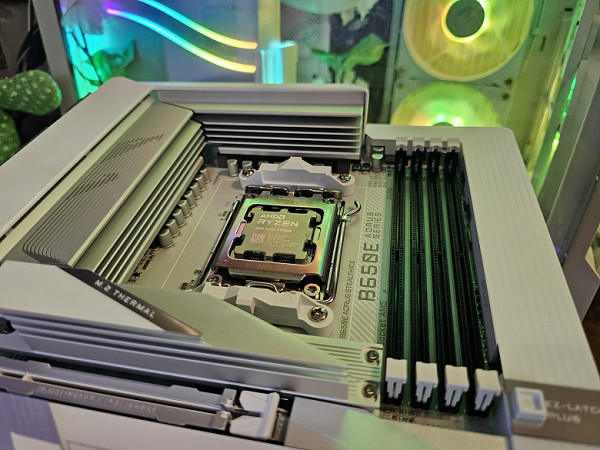
The Gigabyte B650E Aorus Stealth Ice motherboard offers 19 different USB ports, including high-speed USB 3.2 Gen2×2 and Gen2, as well as support for display transmission via a USB Type-C connector. The PCIe x16 slot receives 16 PCIe 5.0 lanes from the processor, similar to one of the M.2 slots (M2A_CPU), while the other two M.2 slots are connected via PCIe 4.0 lanes. This model also includes 4 SATA ports and 6 fan headers. Despite its formal belonging to the mid-price segment (according to the chipset), the CPU power system has a high power. The board is equipped with a cooling system for all potentially hot components, including drives in the M.2 slots. In terms of networking, the board offers a wired controller for 2.5 Gbps and wireless functions Wi-Fi 7 and Bluetooth 5.4. Among the advantages, we can note the elegant and attractive backlight, as well as a wide range of connection of additional RGB devices.
In addition, the Gigabyte B650E Aorus Stealth Ice provides overclocking opportunities, which will be a plus for enthusiasts.
The Need for Cases That Support Stealth Design
Gigabyte calls this design the Stealth concept.
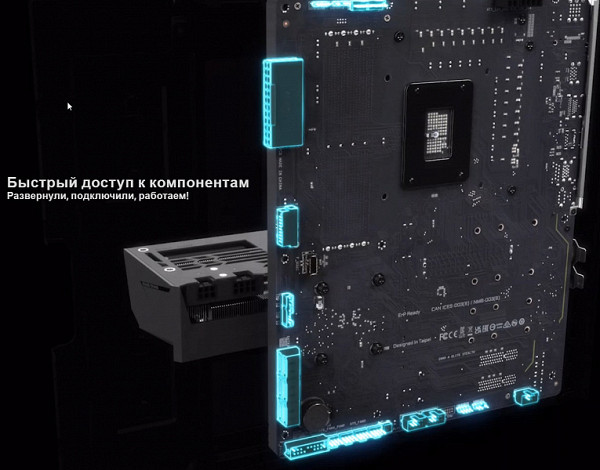
Naturally, to install such motherboards, you need cases that have cutouts in the carrier panel opposite all the connectors transferred to the back side.

On the company's website you can find a list of compatible cases; at the time of preparing the review it looked like this:
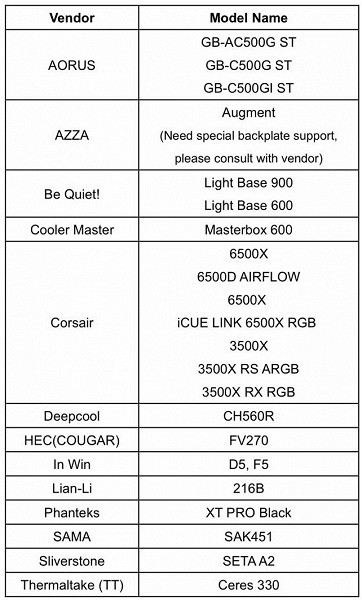
The range of such cases is expected to expand.

